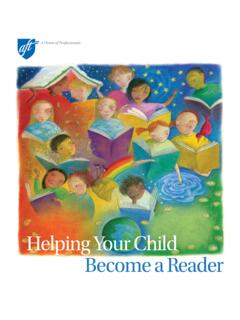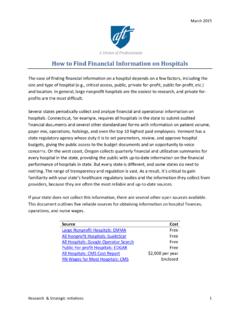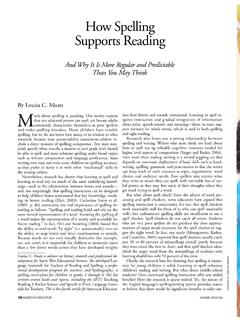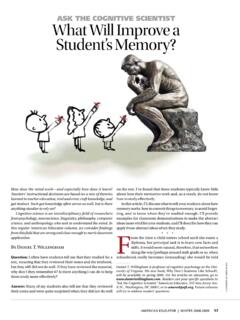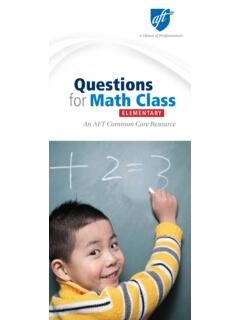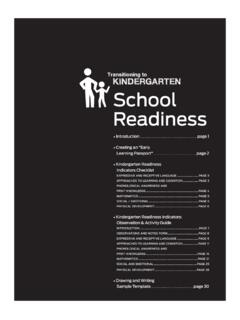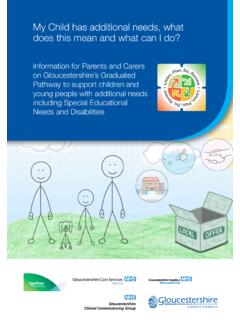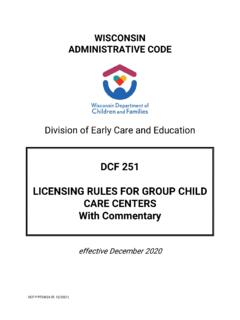Transcription of The Medically Fragile Child: Caring for Children with ...
1 Caring for Children with Special Healthcare needs in the School SettingTheMedicallyFragileChildRandi Weingarten, PresidentAntonia Cortese, Secretary-TreasurerLorretta Johnson, Executive Vice PresidentCopyright American Federation of Teachers, afl-cio (AFT) is hereby granted to AFT state and local affiliates to reproduce and distribute copies of this work for nonprofit educational purposes, provided that copies are distributed at or below cost, and that the author, source and copyright notice are included on each copy. Any distribution of such materials by third parties who are outside of the AFT or its affiliates is prohibited without first receiving the express written permission of the ..iChapter 1 Overview: Children with Special Healthcare needs ..1 Chapter 2 The Role of the School Nurse ..9 Chapter 3 The Legal Framework for Providing Care to Children with Special Healthcare needs .
2 15 Chapter 4 Non-Nursing School Personnel ..31 Chapter 5 Creating a Safe Environment: Protecting Staff and Students ..39 Chapter 6 Collective Bargaining and Workers Rights ..45 Appendices ..50 ContentsWe must advocate for Children with special healthcare needs to obtain the best possible presence of Children with special healthcare needs in schools has broadened the responsibilities of teachers, school nurses, paraprofessionals and other school employees. As members of the education team, we struggle to balance our obligation to students and our concern about duties we may be unprepared or legally not allowed to 1989, the AFT heard these concerns from our members and responded by creating the Ad Hoc Committee on Healthcare Responsibilities in Special Education. This committee was a collaborative effort of the AFT s educational issues department (AFT Teachers), the Federation of Nurses and Health Professionals (now AFT Healthcare), and the AFT s paraprofessional and school-related personnel division (AFT PSRP).
3 The work of this committee generated the first edition of a manual titled The Medically Fragile child in the School Setting. The AFT s Task Force on Special Education continued to work on these issues, and its recommendations were incorporated in a second edition of the third edition sets out to accomplish three goals: first, to educate our members on their roles and responsibilities in relation to Children with special healthcare needs (sometimes referred to as Medically Fragile students ); second, to educate our members on their rights as school employees; and third, to outline possible solutions and protections for local unions to pursue on behalf of their members. The number of Children with special healthcare needs in school settings has increased exponentially since this manual s inception. This trend was one of the catalysts for the community schools proposal that we launched at the most recent AFT convention.
4 The AFT faces multiple challenges related to this trend: We must advocate for an environment that would enable these students to obtain the best possible education, ensure our members have access to information that will support all our students, maintain a safe work environment, and protect members rights. We hope this third edition of the manual will meet these challenges. ForewordRANDI WEINGARTENP residentANTONIA CORTESES ecretary-TreasurerLORRETTA JOHNSONE xecutive Vice PresidentFOREWORD / iBecause each child is unique, his or her educational program must be determined on a case-by-case Medically Fragile child / Overview 1 Are you astounded that teachers and paraprofessionals are expected to provide nursing care to students in addition to teaching them?Do you find it hard to believe that districts expect schools to share nurses and that vacant school nurse positions are not being filled, at the same time that increasing numbers of Children with serious health conditions are being enrolled?
5 Do you know teachers and paraprofessionals who feel legally vulnerable because they are being asked to perform nursing procedures for Children with special healthcare needs ?Do you worry that the education of students might suffer because of the amount of time teachers and paraprofessionals spend on nursing tasks rather than on teaching? Do you see the benefits of integrating most Children with medical conditions into typical school settings but wish it could be done on a case-by-case basis, with access to essential support services?These are only a few of the questions, issues and, in some cases, controversies surrounding the education of Children with special healthcare needs . Who Are Children with Special Healthcare needs ?There is no universally accepted definition of Children with special healthcare needs . The term generally refers to students who require complex health procedures, special therapy or specialized medical equipment/supplies to enhance or sustain their lives during the school each child s condition is unique, his or her educational program must be determined on a case-by-case basis.
6 The same holds true for the development of his or her school-based individualized healthcare plan (IHCP).Until the 1980s, Children with special healthcare needs were most often cared for in hospitals or institutions that saw to their educational, developmental and medical needs . However, the trend toward deinstitutionalization, combined with the pressure for healthcare cost containment, resulted in Children being moved into community settings. In addition, advances in healthcare technology have enabled more Children to leave hospitals and attend public schools than in previous : Children with Special Healthcare NeedsChapter 12 AFTThe Laws Relating to Children with Special Healthcare NeedsThe Individuals with Disabilities Education Act (IDEA) and its 1975 precursor, known as the Education for All Handicapped Children Act (EAHCA) or Public Law 94-142, have changed the landscape of education in America, along with the lives of Children with special healthcare provides Children the right to a free appropriate public education in the least restrictive environment (LRE) appropriate to their needs .
7 Least restrictive environment is defined as when: to the maximum extent appropriate, Children with disabilities .. are educated with Children who are not disabled, and special classes, separate schooling or other removal of Children with disabilities from the regular educational environment occurs only when the nature or severity of the disability is such that education in regular classes with the use of supplementary aids and services cannot be achieved satisfactorily. 1 The initial passage of Public Law 94-142 meant that large populations of Children and youth with special healthcare needs students who previously had been underserved or not served at all by public schools were now entitled to an education provided by the public school system. The 1990 reauthorization expanded the eligible student population to include preschool students. Since the inception of IDEA, the number of young people ages 3 21 enrolled in public schools and receiving special education services has increased nearly every year.
8 In 1976 77, some million youth (or 8 percent of the total public school population), received services under IDEA. By 2005 06, that number had increased to million, or 14 percent of total public school Is Eligible for IDEA? To be considered IDEA-eligible, a student must be diagnosed with one or more of the disabilities listed in the federal statute, and must require special education instruction and/or related services as a result of that disability. The statute lists 13 basic disabilities, which are listed below. States may choose to add additional categories to this list, and the statutory language may vary somewhat from state to state as Deaf-Blindness Deafness Emotional Disturbance Hearing Impairment Mental Retardation Multiple Disabilities Orthopedic Impairment Other Health Impairment Specific Learning Disability Speech or Language Impairment Traumatic Brain Injury Visual Impairment Including Blindness THE Medically Fragile child / Overview 3 The Individualized Education Program (IEP) contains, among other things, a statement of the specific special education and related services to be provided to the child , and of the extent to which the child will be able to participate in regular education programs.
9 The IEP is an essential document for the IDEA-eligible child ; it is the road map for the services that the school district must provide to the is determined by a multidisciplinary team, including at least one educator when appropriate. Once the student is declared eligible, an Individualized Education Program (IEP) is developed. Section 504 of the Rehabilitation Act of 1973 Section 504 of the Rehabilitation Act of 1973 is a federal law that protects the civil rights of persons with disabilities. Under Section 504, no one with disabilities can be denied access to any program or activity that receives federal funds. A student with a disability may be eligible for Section 504 protection if he or she has a physical or mental impairment that substantially limits one or more major life activities. 4 Examples of an impairment may include attention problems, severe allergies, cerebral palsy, diabetes or epilepsy.
10 Substantially limits means the student is significantly restricted in performing major life activities such as walking, seeing, hearing, speaking, breathing and learning as compared with a peer in the general IDEA-eligible students also are covered by Section 504, but the reverse is not true. The population of Section 504-eligible students is much larger than the population of IDEA-eligible students. Most students who are only eligible to receive services under Section 504 receive them in a general education school is required by law to have a process in place to identify Children who may qualify for Section 504 status. Often, there is a coordinator who is part of that process. If a parent or teacher believes that a child may qualify, he or she should find out what the process is in their school district. The evaluation to determine whether the child qualifies for Section 504 will be conducted by a team made up of individuals who are familiar with the child , most likely including the child s teacher.
